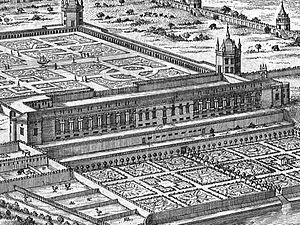Alexius Payos
Alexius Payos (also Paiosc , * in Monte Magre in the district of Schio , province of Vicenza , Italy ; † January 25, 1591 in Kaisersteinbruch , Hungary , now Burgenland ) was an Italian master stonemason and sculptor of the Renaissance .
He was the brother of Elias Payos . His father came from Valli del Pasubio near Monte Magre. An interesting story: there is a settlement there called Paiosa with a few inhabitants of the same name, and there was a quarry nearby .
Life
From Monte Magre in the Schio district, three master stonemasons can be identified from the 2nd half of the 16th century in Kaisersteinbruch, the brothers Alexius and Elias Payos and Augustin Rigobello . They came from long-established families . These stonemasons often changed their whereabouts and stayed for a long time at their construction sites where there was enough work.
Orders for imperial buildings
A Tyrolean-South Bavarian dialect was spoken in Monte Magre , which is why these building professionals did not have to feel like strangers in German-speaking countries. The quarry on Leithaberg was again an Italian language island, so the best conditions were given for a smooth communication. The journeyman Alexius Payos worked for Master Bartholomäus Pethan , a compatriot from Northern Italy, on the imperial buildings and the stable castle and became a master himself. In the 1570s they first worked on the western gallery, then the eastern gallery for Neugebauten Castle . Emperor Rudolph II moved his residence to Prague . The castle, which was planned for the ruling Roman emperor, lost its importance right from the start. In 1577 he took the boy Giacomo Murato on as an apprentice and released him in 1582 as a journeyman .
There were also dramatic consequences for the order situation in the construction industry in the imperial quarry. The Heiligenkreuz Abbey awarded some works. In the letters accompanying the invoices to the abbot, formulated in German, they refer to their difficult situation, ask to do the accounting as soon as possible , ... because they have to keep their wives and children with hard work , they have nothing else to do with living and working have as this quarry stone , they need the money to give your grace what they owe (lease).
Epitaph in summer
The quarry did not yet have its own church , so the parish in the neighboring community of Sommerein was responsible for the quarries. That is why the epitaph of Alexius has been preserved in Sommerein.
The inscription reads:
FOR HIS MERIT. WHAT DOES THIS WORLD MEAN, WHAT'S FAME OR TRIUMPH? AFTER THE Miserable BURIAL WE ARE DUST AND SHADOW. IN THE YEAR OF THE LORD, 1591, ON THE DAY OF CONVERSION OF PAUL DIED IN CHRIST THE VENIOUS AND EXCELLENT MASTER ALEXIUS PAYOS, ITALIAN, STEINMETZ, BORN IN MONTEMAGRE, WHO HAVE BEEN GRATEFUL FOR HIS ARTWORKS, POSTED THE TROUBLE. THE HEIRS HAVE SITUATED THE MONUMENT.
(Translation: Hans Taeuber , University of Vienna, Institute for Ancient History, Classical Studies and Epigraphy.)
His son Ulrich Payos, master stonemason, sold the property in 1628 and left the quarry.
Works
- around 1560: Imperial buildings in Vienna, Stallburg
- around 1570: New building
- 1585: kneeling statue of the Virgin Mary made of hard white Kaiserstein , central figure of the Kaisersteinbruch cemetery portal
- October 5, 1587: Stonemason invoices to Abbot Johannes Rueff of the Heiligenkreuz Abbey , for
- Heiligenkreuz Abbey: Building (prelature) in the Heiligenkreuzerhof in Vienna
- Heiligenkreuz Abbey: New Church in Trumau
- Heiligenkreuz Abbey: Königshofer Mühle
literature
- Paolo Snichelotto: Monte Magre nella storia, Alessio q. Antonio Paioso, Rigobello .
- Letter from the Schio municipal library to Eva Pelnöcker (†) in Sommerein : Migrant workers from the Schio district .
- Hilda Lietzmann : The new building in Vienna . German art publisher, 1987.
- Stone explorations by Andreas Rohatsch , Vienna University of Technology, engineering geology: Neugebauten-Gloriette in Schönbrunn Palace .
- Heiligenkreuz Abbey archive: register, stonemason invoices .
- Alexius, Elias and Ulrich Payos. Three Italian stonecutters from Leithaberg from the early days of the quarry . In: Helmuth Furch , communications from the Kaisersteinbruch Museum and Culture Association . No. 27, 1993, pp. 12-21. ISBN 978-3-9504555-3-3 .
- Payos Alexius . In: Felix Czeike , Historisches Lexikon Wien . Volume 5, Vienna 1995.
- Helmuth Furch: Historical Lexicon Kaisersteinbruch . 2 volumes. Museum and cultural association, Kaisersteinbruch 2002–2004. ISBN 978-3-9504555-8-8 .
| personal data | |
|---|---|
| SURNAME | Payos, Alexius |
| BRIEF DESCRIPTION | Italian master stonemason of the Renaissance |
| DATE OF BIRTH | 16th Century |
| PLACE OF BIRTH | Monte Magre in the district of Schio , Province of Vicenza , Italy |
| DATE OF DEATH | January 25, 1591 |
| Place of death | Kaisersteinbruch , Hungary , now Burgenland |


